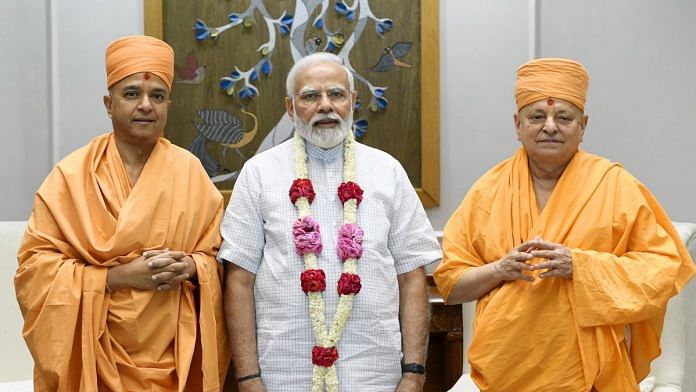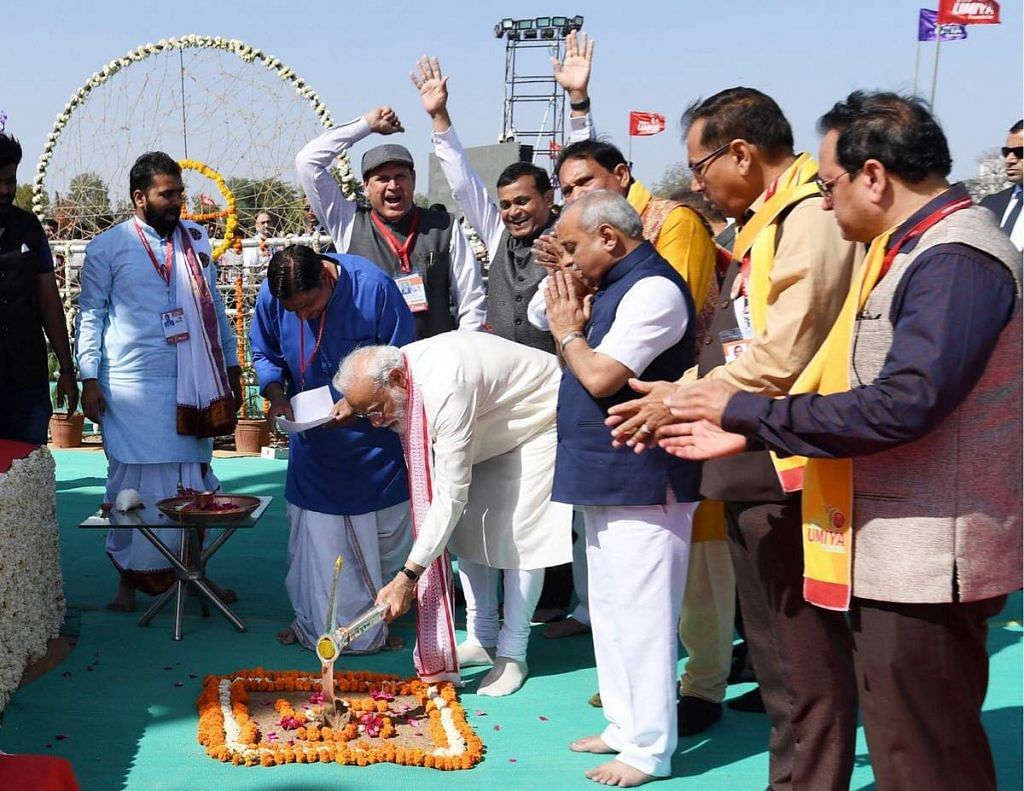
New Delhi: Prime Minister Narendra Modi landed in Ahmedabad this Monday for a three-day tour of his home state Gujarat, where he is visiting schools and inaugurating various development projects.
But, over the past 10 days or so, the PM has also been marking his presence, even if virtually, at several religious and spiritual events in the state, which goes to polls later this year.
The Prime Minister’s busy calendar this fortnight has included inaugurating an educational complex run by a religious trust, meeting senior leaders of the powerful Swaminarayan sect, and unveiling a 108-ft Hanuman statue in Gujarat.
In a state where Hindus make up about 88 per cent of the population and where spiritual leaders and sects wield great influence on important communities like the Patidars, it is essential to stay plugged into the religious circuit, Gujarat BJP leaders told ThePrint.
“The Prime Minister has developed a good equation with the gurus of all sects — it is like a family relationship,” a state BJP leader said.
“[Modi] knows every detail of the work that the religious trusts are doing and, from time to time, also gives them suggestions about what issues to tackle. In some instances, he knows two or three generations of gurus from his early days in the RSS,” he added.
Gujarat is home to several Hindu orders that do not just offer spiritual guidance but also perform various charitable activities and exert considerable hold over important communities.
While some religious orders claim to be apolitical, their support ahead of elections is sought after by political parties.
Also Read: Behind Modi & Dr Tedros’ smiles in Gujarat, India & WHO are at war over Covid deaths, Covaxin
Modi’s religious outreach in Gujarat
On 10 April, PM Modi appeared via video link at the 14th Foundation Day celebrations of Umiya Mata Temple in Junagadh, where he spoke of how places of “spiritual and divine importance” were also key to spreading social consciousness.
Umiya Mata is the kuldevi (tutelary deity) of the politically important Kadva Patidar community in Gujarat.
Modi, who had inaugurated the temple in 2008 when he was Gujarat Chief Minister, talked about the need to curb malnutrition among children and expectant mothers and asked the temple trust to hold “healthy baby competitions” in villages and to use temple halls for yoga classes.
Two days later, on 12 April, Modi made his virtual way to another site of importance to the Leuva subgroup of the Patidar community — the Shri Annapurna Dham in Adalaj near Ahmedabad. Here, the PM inaugurated an educational complex and hostel, and also performed the bhumipujan (ground-breaking ceremony) of the Hiramani Aarogyadham of the Jansahayak Trust.
In his speech, Modi made explicit mention of the largely land-owning, agrarian Patidar community, which he said performed an important function in society. He also said that he was pleased to have had a long association with the spiritual and social initiatives of Shri Annapurna Dham.
Modi pointed out that a stolen statue of the goddess Annapurna was brought back to Varanasi from Canada last year. “Dozens of such symbols of our culture, have been brought back from abroad in the last few years,” he said.
Next on the agenda for the PM was the unveiling of a 108-ft Hanuman statue at Morbi in the Kathiawar peninsula, on 16 April.
Today, we mark the special occasion of Hanuman Jayanti. In Morbi, at 11 AM, a 108 feet statue of Hanuman ji will be inaugurated. I am honoured to be getting the opportunity to be a part of this programme via video conferencing. https://t.co/qjvLIHWWiO pic.twitter.com/kbHcIxd90Z
— Narendra Modi (@narendramodi) April 16, 2022
In his video address at this ceremony, Modi mentioned that the statue was the second out of four being built in all directions of the country as part of the ‘Hanuman ji Char Dham’ project.
“Hanuman ji is the manifestation of power and strength who gave equal rights and respect to all the forest dwellers. That is why Hanuman ji has an important link with ‘Ek Bharat, Shreshtha Bharat‘ (a cultural ‘unity in diversity’ initiative of the government) too,” Modi said, going on to reminisce about his close ties with Morbi and visits with the late priest Keshvanand Bapu.
He also referred to the growing industries of Morbi, Jamnagar, Rajkot, Kutch, describing the region as a “mini Japan”.
Two days later, the PM met two senior leaders of the influential Bochasanwasi Akshar Purushottam Swaminarayan (BAPS) Sanstha, later tweeting that he “appreciated” their Covid and Ukraine relief work and had discussed the “upcoming birth centenary celebrations of HH Pramukh Swami Maharaj Ji”.
Gujarat BJP vice-president Janakbhai Patel told ThePrint that religious leaders’ influence in the state extended well beyond their temples.
“Gujarat is religious society and religious gurus have a huge impact on followers. This is not only due to religion but because of their social work in education, healthcare, and women’s empowerment,” he said. “They also have several temples abroad and a large following among the diaspora.”
“They seek guidance from the Prime Minister from time to time for more involvement in focused social work,” he added.
Another Gujarat BJP leader said that though sect leaders generally refrained from articulating their political affinities, “their support can be understood from their gestures”. The PM’s relationship with many of these gurus, he added, is “very personal”.
Patidars and temple politics in Gujarat
Comprising about 17 per cent of Gujarat’s population, the Patidar community — often recognisable by the surname ‘Patel’ — is widely understood to be the “driving force” behind governments in Gujarat.
Every third legislator in the state belongs to the community, which also wields considerable financial power. However, Patidar agitations for OBC status have in the past caused concerns for the BJP.
In a state where religion and politics are intertwined, the temples of the community are often high on the must-visit lists of politicians ahead of elections.
An instance of the community’s clout is a widely reported instance from 2018, when Vishwa Umiya Foundation raised Rs 150 crore in just three hours for the construction a Rs 1,000-crore temple-cum-community complex.
The next year, just ahead of the 2019 Lok Sabha elections, Prime Minister Modi performed the groundbreaking ceremony for the Vishwa Umiya Dham Complex in Jaspur, Gandhinagar district. Two years later, Home Minister Amit Shah laid the foundation stone of the ambitious temple complex, which is due to be completed in 2024.

Similarly, ahead of the 2012 Gujarat assembly polls, Modi attended the groundbreaking ceremony of the Shree Khodaldham Temple of the Leuva Patidars.
Five years later, before the 2017 assembly elections, the PM was also present at the inauguration of this temple. Congress leader Rahul Gandhi, too, visited this temple ahead of the polls in 2017.
At that time, the Hardik Patel-led agitation seeking OBC status for the Patidar community had brought the state to a boil, putting the BJP in a somewhat precarious position. It won the election but registered its worst performance since 1995, when it first came to power in Gujarat.
The Congress, meanwhile, had gained ground on the back of the agitation. In 2015, too, Patidar discontent caused the BJP worries ahead of the municipal polls, although it did end up winning.
While the Patidar agitation has died down, the community still represents a challenge, especially with speculation rife that Naresh Patel, chairman of the Shree Khodaldham Trust, might join the Congress.
The wealthy Swaminarayan sect is also important, especially for its reach among the Gujarati diaspora in the US and Europe. When the temple’s head priest died in 2016, Modi travelled from Delhi to pay his respects. This sect, too, has a large following among the Patidar community.
Aam Aadmi Party (AAP) chief Arvind Kejriwal, who hopes to make inroads into Gujarat, made it a point to offer prayers at Ahmedabad’s Swaminarayan Temple ahead of launching the poll campaign in the state this month.
“Brahmins comprise only 1 per cent of the population in Gujarat and it is the Patidar middle-class that influences society the most,” Gaurang Jani, assistant professor of sociology at Gujarat University, said.
“Patidar Gods, their sects, their temples have became modern centres of influence in Gujarat. That is the reason every party woos them during elections. Even the Dalits and tribals look towards them as role models,” Jani added.
(Edited by Asavari Singh)
Also Read: Who are Patels and how they have become a driving force behind govts in Gujarat

COMMENTS